A couple days ago I read this in Wikipedia’s entry called Chess endgame:
Queen and bishop versus two rooks. This was thought to be a draw [before computer tablebases — DM] but the queen and bishop usually win. It takes up to 84 moves.
This got me curious. Like most players, I only know the basic pawnless endgames: K+Q vs. K, K+R vs. K, K+2B vs. K, etc. My impression was that every other pawnless endgame is ridiculously rare and ridiculously difficult.
But I started wondering: could I use the Nalimov tablebases to learn something about the Q+B vs. 2R endgame? Are there some rules for playing this endgame that ordinary humans can understand?
The answer is yes! First, there are some drawn positions for Black. In fact, it’s easier to say how Black draws than to say how White wins. Here is a rule that I figured out last night:
Rule 1. Black draws if he can put his rooks side by side on the third rank, [and not on the two central files — clarification added 11/16] in such a way that the rook closer to the side of the board pins the bishop against White’s king. There is only one exception (see below.)
Here is a typical example:
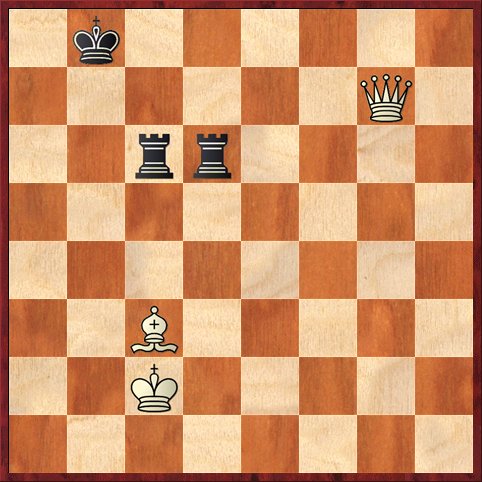 FEN: 1k6/6Q1/2rr4/8/8/2B5/2K5/8 w – – 0 1
FEN: 1k6/6Q1/2rr4/8/8/2B5/2K5/8 w – – 0 1
Starting Position 1.
As you can see, the rooks are side-by-side on the third rank, the c-rook pins the bishop, and the d-rook prevents White’s king from escaping to the long side. This is important! If the rook were on b6 instead of d6, White would be winning. But here, White to play cannot make any progress. If he tries to unpin the bishop with 1. Kb3, Black plays 1. … Rb6+. Now if White continues to move the king forward, he just gets chased around forever. The rook on d6 serves as the sentry that keeps the king from escaping the box, while the other rook does the checking.
Alternatively, if White interposes the bishop with 2. Bb4, then Black simply moves the “sentry” rook to c6: 2. … Rdc6. Now White’s position is even worse than before! The White king is confined to a smaller box.
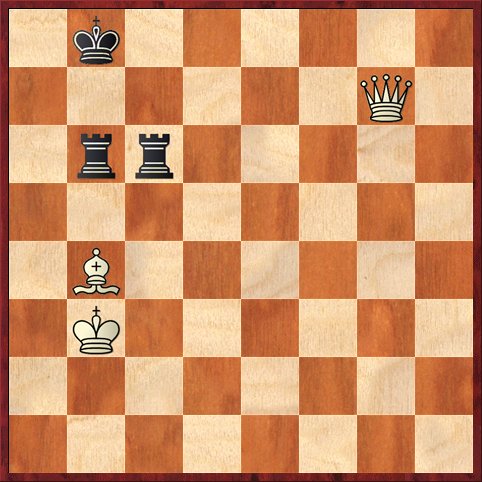 FEN: 1k6/6Q1/1rr5/8/1B6/1K6/8/8 w – – 0 3
FEN: 1k6/6Q1/1rr5/8/1B6/1K6/8/8 w – – 0 3
Position after 2. … Rc6.
If we go back to Starting Position 1, you might wonder whether White can make progress with a queen move rather than a king move. The answer is no. The only way the queen can help is to pin one of the rooks, either the sentry rook or the mobile rook. Thus, in the initial position, either 1. Qe5 or 1. Qg3 would be a good try. However, if White does this, Black merely steps to the side (1. … Ka8) and White has not made progress.
A more interesting, in fact beautiful, draw arises if we move the king and bishop one rank closer.
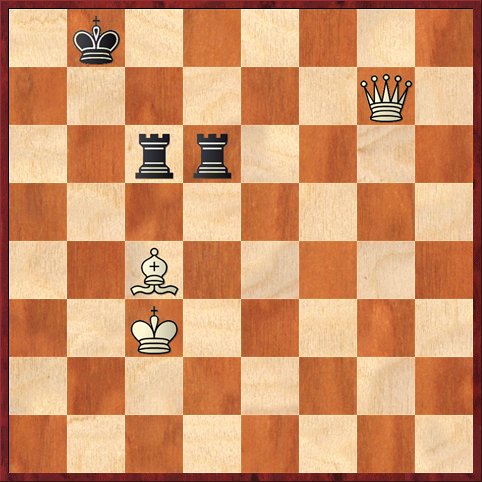 FEN: 1k6/6Q1/2rr4/8/2B5/2K5/8/8 w – – 0 1
FEN: 1k6/6Q1/2rr4/8/2B5/2K5/8/8 w – – 0 1
Starting Position 2.
This is still a draw, but it takes a miracle! Here is best play for both sides according to the tablebase.
1. Kb4 (breaking the pin) Rb6+ 2. Ka5 (the king can’t be checked here) Rdc6 (same idea as before — making the box smaller) 3. Bd3 (preparing to bring the bishop to the long diagonal) Kc8 4. Qe7 Kb8 5. Qd8+ Ka7 6. Bb5! (seemingly decisive, because the rook is overworked — it has to defend the other rook and the square c7) Rd6 7. Qc7+ Ka8 8. Be2. Once again White’s bishop is heading to the long diagonal, and this time it appears fatal.
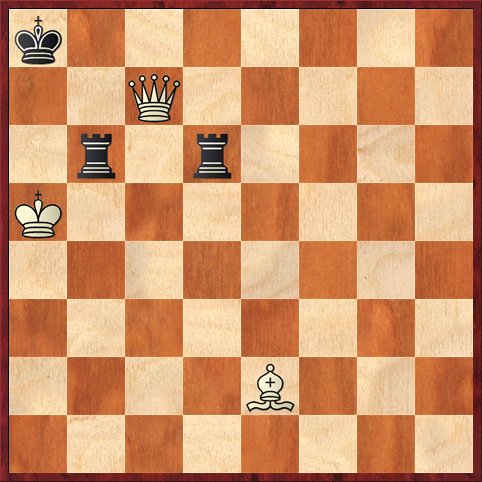 FEN: k7/2Q5/1r1r4/K7/8/8/4B3/8 b – – 0 8
FEN: k7/2Q5/1r1r4/K7/8/8/4B3/8 b – – 0 8
Position after 8. Be2. Black to play and draw!
Do you see the miracle draw? Hint: look for stalemates.
The answer is 8. … Ra6+!! If White accepts the sacrifice, 9. Bxa6 Rxa6+, obviously he can’t take the second rook because 10. Kxa6 is stalemate. But if he plays 10. Kb5, the rook continues its desperado ways with 10. … Rb6+!!
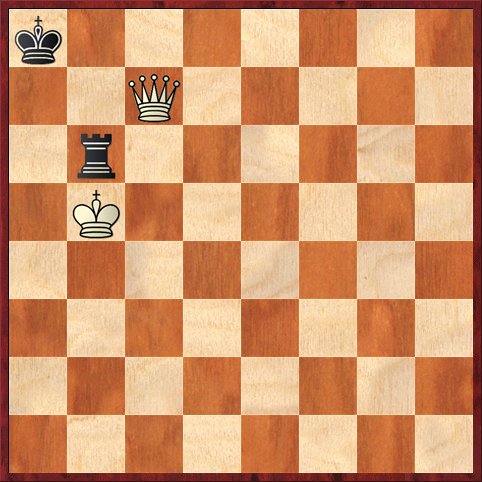 FEN: k7/2Q5/1r6/1K6/8/8/8/8 w – – 0 11
FEN: k7/2Q5/1r6/1K6/8/8/8/8 w – – 0 11
Position after 10. … Rb6+.
Amazingly, White’s king has no escape from the checks. If 11. Kc5 then 11. … Rb5+! Black keeps checking on the first six ranks forever — unless the king moves to the seventh rank, and then … Rb7 will skewer the queen and king and lead to an immediate draw.
Incidentally, you might be wondering, “What is so special about the third rank? Wouldn’t Black still be drawing if he has his rooks side by side on the fourth rank?” Well, the above line is one case where it makes a difference. If we moved everything down one rank in Starting Position 2, Black wouldn’t have had this stalemate trick.
The only exception to Rule 1 occurs if we move the bishop one step closer to the rooks.
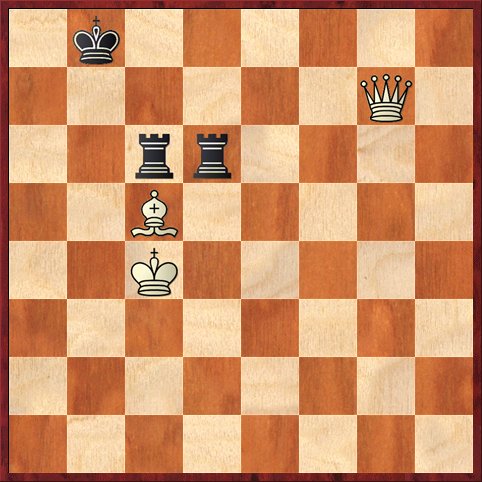 FEN: 1k6/6Q1/2rr4/2B5/2K5/8/8/8 w – – 0 1
FEN: 1k6/6Q1/2rr4/2B5/2K5/8/8/8 w – – 0 1
Starting Position 3.
The reason for this exception is obvious. After 1. Kb5 White breaks the pin, Black cannot play … Rb6+, and now he has to move his “sentry” rook away from d6.
White can make use of this knowledge, too. Here is another study taken straight from the Nalimov tablebase. (Actually, we’re starting at move 10 of a different variation I was looking at, but never mind that.)
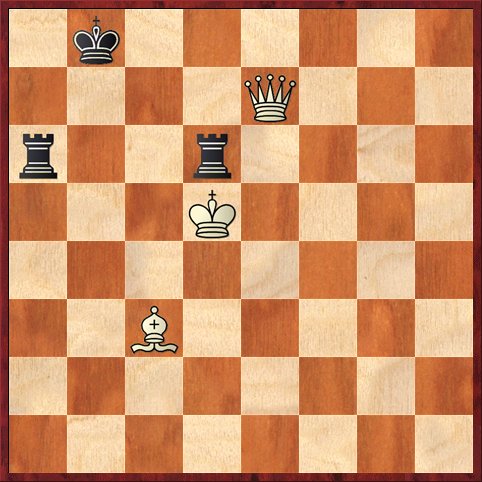 FEN: 1k6/4Q3/r2r4/3K4/8/2B5/8/8 w – – 0 10
FEN: 1k6/4Q3/r2r4/3K4/8/2B5/8/8 w – – 0 10
Position after 9. … Rd6+. White to play and win.
After the above discussion, this position is a piece of cake. White has only five ways to get out of check. Taking on d6 obviously leads to a draw. 10. Ke5? likewise draws immediately, because of 10. … Re6+! forking the king and queen. Both 10. Kc4? and 10. Kc5? put White’s king in the box set up by the “sentry” rook on d6, and as we have seen above, after 10. … Rac6+ White has no way to make progress.
Therefore, by elimination, the winning move has to be 10. Ke4! At first this looks crazy, because Black once again can fork the king and queen with 10. … Re6+. Now, however, White can interpose with check: 11. Be5+! and it’s mate in three after 11. … Ka8 12. Qd8+ Kb7 13. Qc7+ Ka8 14. Qb8 mate. Of course, Black can delay the inevitable by giving up the exchange with 11. … Rxe5, but that’s a book win for White. Actually, Black’s best defense after 10. Ke4 is 10. … Kc8, but 11. Be5! is still extremely strong. (See diagram.)
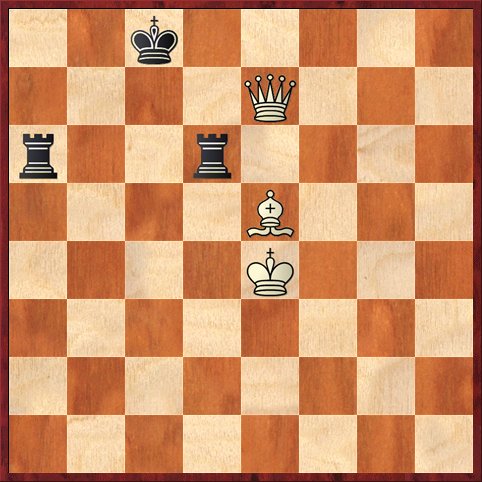 FEN: 2k5/4Q3/r2r4/4B3/4K3/8/8/8 b – – 0 11
FEN: 2k5/4Q3/r2r4/4B3/4K3/8/8/8 b – – 0 11
Position after 11. Be5. Black to move.
The main point is that after Black’s natural answer, 11. … Rdc6, White checkmates in two moves with 12. Qe8+! Kb7 13. Qb8 mate. If the d-rook moves to any other square on the third rank, 12. Qc7 will be mate. Therefore Black is forced to disconnect his rook battery, either with 11. … Rd7 or 11. … Ra4+. Usually in this endgame it’s death for the rooks to get separated, and it’s certainly true here. I’ll let you work out the win from here.
The end of this example gives us an idea of how White typically wins this endgame. I would say that it’s a lot harder for White to win than it is for Black to draw, even though theory says that White is winning. The reason is that the usual principle of “chase the defender’s king to the edge of the board” is not completely accurate here. The winning checkmate often does not occur at the edge of the board; the above position was an example. White has to have a great deal of ingenuity to come up with these kinds of checkmates. One might say, computer-like ingenuity.
To the extent that I can give any general advice to White, it is this:
1) Centralize the king. The king is often a secret weapon in setting up the unusual checkmates required in this endgame.
2) Do not let your bishop get pinned (except if it’s on the d- or e-file). If it gets pinned, try to unpin it as quickly as possible.
3) Use unconventional checkmate threats to either force Black’s rooks to disconnect from each other or to force one of them to give itself up for the bishop.
I will close with two more examples that illustrate the last idea. “White to play and mate or convert in 3” means that either White mates in 3 moves or Black has to give up the exchange, thereby “converting” to a book win.
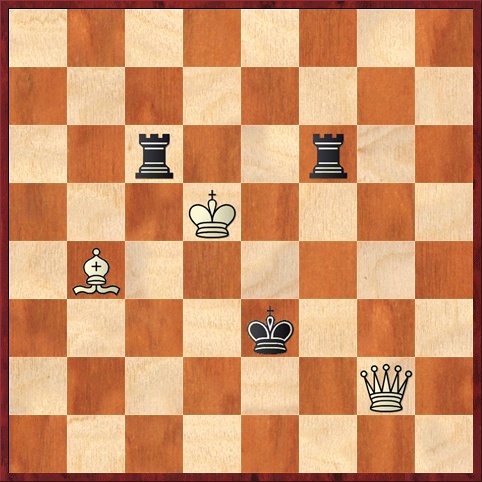 FEN: 8/8/2r2r2/3K4/1B6/4k3/6Q1/8 w – – 0 1
FEN: 8/8/2r2r2/3K4/1B6/4k3/6Q1/8 w – – 0 1
Problem 1. White to play and mate or convert in 3.
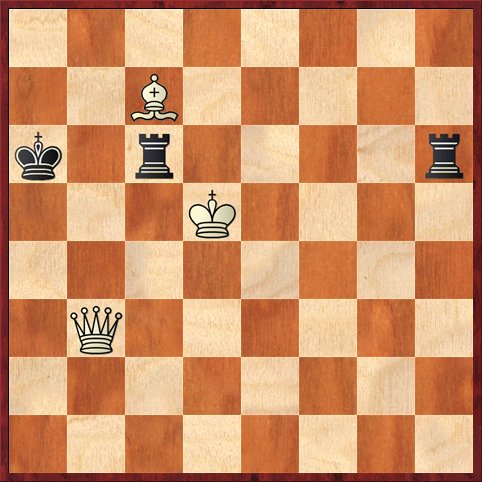 FEN: 8/2B5/k1r4r/3K4/8/1Q6/8/8 w – – 0 1
FEN: 8/2B5/k1r4r/3K4/8/1Q6/8/8 w – – 0 1
Problem 2. White to play and mate or convert in 3.
Answers:
Problem 1. After 1. Be7! if Black moves his rook — say 1. … Rg6 — then White has an “unconventional mate” with 2. Bg5+ Kd3 3. Qd2 mate. It’s clear that Black has to give up the exchange to prevent this mate.
Problem 2. After 1. Qb8! White threatens the unconventional mate 2. Qa8+ Kb5 3.Qa5 mate. It’s clear that Black has to give up the exchange to prevent this mate.



{ 1 comment… read it below or add one }
Nice entry; thanks for the effort and useful ideas. I should try to find some games that play out with two r vs. q b for additional instruction.